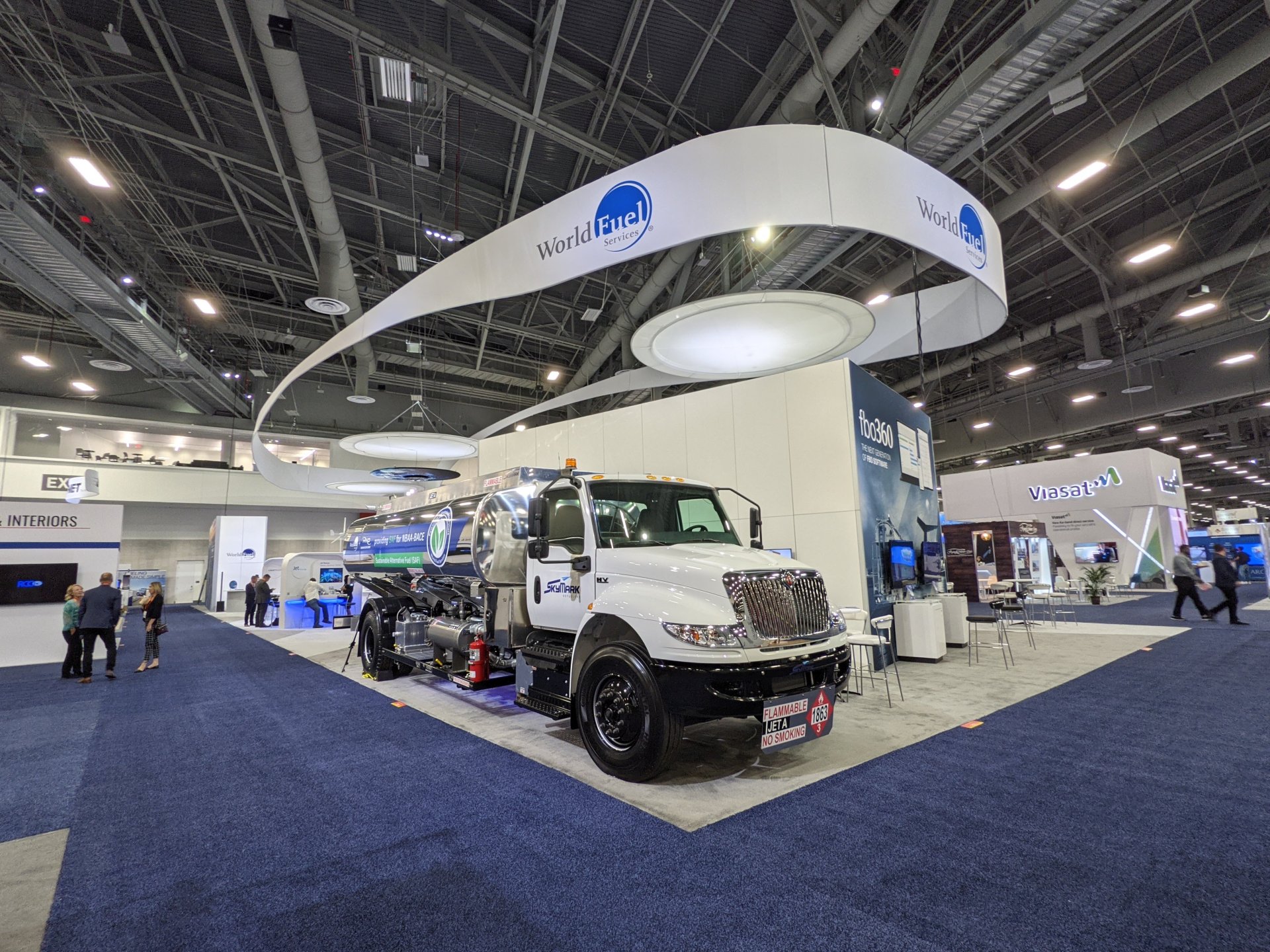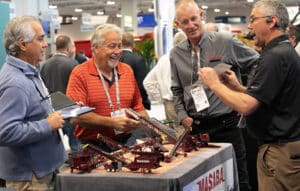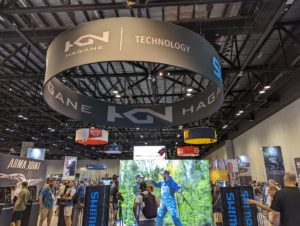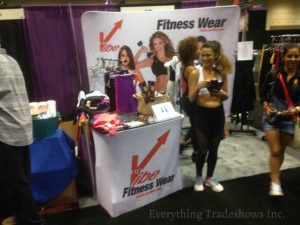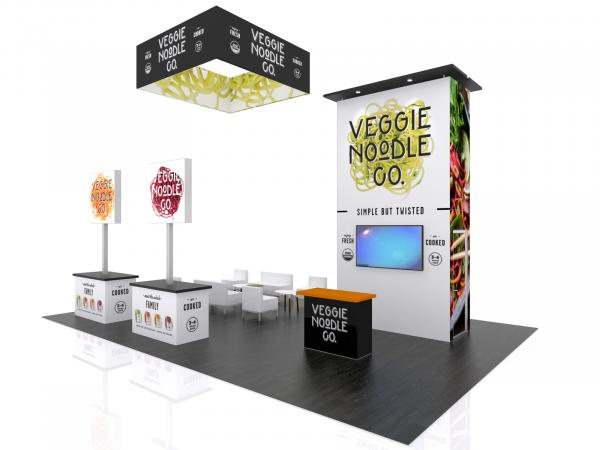Before you dive into the hustle and bustle of a trade show, a solid foundation is key. Pre-planning ensures you’re not only prepared but also steps ahead in the game. It’s all about understanding the rules, setting clear goals, and designing a booth that stands out. Let’s break down these essential steps to get you organized and ready.
How to Set Up a Booth at a Trade Show for Maximum Impact
Understand the Trade Show’s Guidelines
Before you start with anything else, it’s crucial to know the rules of the game. Every trade show will have its own set of guidelines. You need to be familiar with these to ensure you don’t run into any last-minute surprises. Here’s what to look out for:
- Booth Dimensions: How big is the space you have reserved? This will dictate everything from the size of your banners to how many chairs you can fit.
- Limitations: Some trade shows might have restrictions, like height limits for displays or specific rules about trade show hanging signs or other items.
- Facilities: Find out about the facilities that are available. Will you have access to power outlets? How about Wi-Fi? Make sure you’re aware of what’s provided so you can plan accordingly.
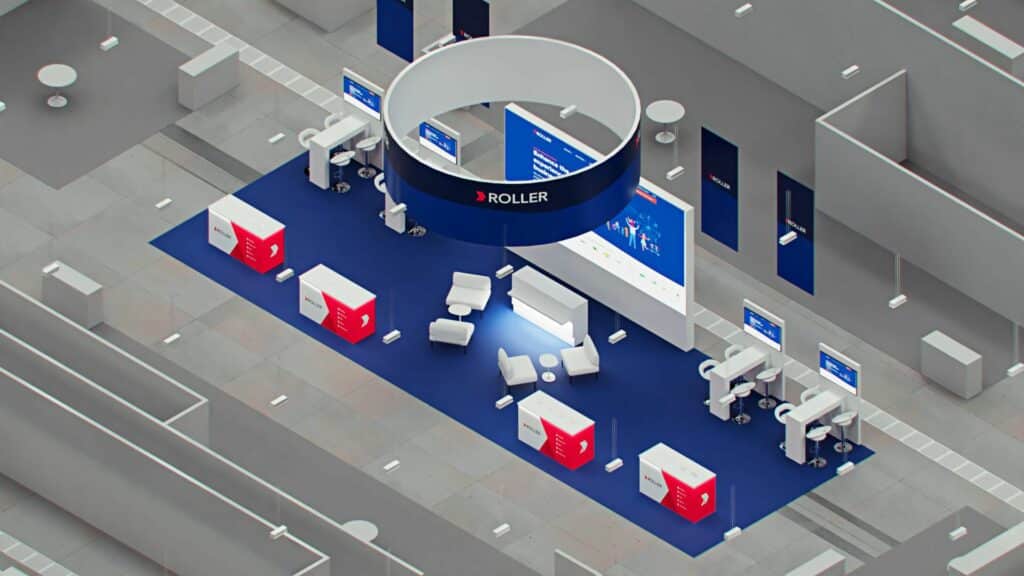
Set Clear Objectives
Before diving into the trade show booth design and setup, it’s vital to understand why you’re there. Are you aiming to:
- Sales: Is your primary goal to sell products during the trade show?
- Brand Awareness: Maybe you want people to recognize and remember your brand, even if they don’t buy anything on the spot.
- Networking: Or, perhaps you’re there mainly to build relationships with other businesses and potential partners.
By defining your objectives clearly, you can design your booth in a way that best supports those goals.
Read my article about how to plan a trade show.
Design Your Booth Layout
Now that you’re clear on the rules and your goals, it’s time to get creative!
- Sketch or Computer Design: Whether you’re a fan of the old-school paper and pencil method or prefer using digital tools, begin by drafting a rough design of your booth. This helps visualize the space and ensures everything fits perfectly.
- Key Elements: Some things will be more important than others. Decide on the main attractions of your booth. Maybe it’s a big banner with your company’s logo, a central table for product demos, or a particular display that showcases your best-selling items. Prioritize these in your design, making sure they grab attention.
Remember, the design phase is essential. It sets the stage for how attendees will perceive and interact with your brand during the show.
Read my article about trade show booth design tips.

How to Set Up a Booth at a Trade Show to Maximize Your Impact
When it comes to trade shows, standing out in the crowd is essential. The secret sauce? Effective branding. A memorable booth is one that resonates with your brand’s identity, ensuring visitors remember you long after they’ve left. Let’s delve into how you can infuse your brand essence into every element of your booth.
Logo and Company Name
Your logo and company name are the primary identifiers of your business. They’re like the face of your brand, so you need to make sure they’re seen:
- Visibility: Place your logo and company name where they can be easily spotted, ideally at eye level or slightly above.
- Size Matters: Depending on your booth’s size, ensure your logo is big enough to be seen from a distance but not so massive that it overwhelms other elements.
- Clear Fonts: If your company name is written out, make sure it’s in a readable font, especially for those passing by quickly.
Read my article about how to attract people to your booth.
Color Scheme
Colors aren’t just for aesthetics; they convey feelings and are a crucial part of your brand’s identity:
- Consistency: Use colors that align with your brand’s established palette. This ensures your booth feels like an extension of your other marketing materials.
- Mood Setting: Remember, colors evoke emotions. For instance, blues might convey trust while reds can denote excitement. Choose shades that reflect the feelings you want to invoke in visitors.
- Accents and Highlights: If you have secondary brand colors, use them as accents or highlights to break the monotony and draw attention to specific areas.
Marketing Materials
Beyond the visual elements of your booth, you’ll interact with attendees using various marketing materials:
- Brochures: These are essential for providing detailed information about your products or services. Ensure they’re well-designed, easy to read, and succinct.
- Business Cards: An absolute must-have for networking. A well-designed card can make a lasting impression.
- Giveaways: Everyone loves freebies! Whether it’s branded pens, tote bags, or any other swag, ensure it’s something useful, so your brand remains with them even after the show. Remember, the key is to offer something that attendees will want to keep and use.
By ensuring your branding is on point, you’ll leave a lasting impression, making your trade show participation all the more successful.
Read my article about trade show giveaway ideas.
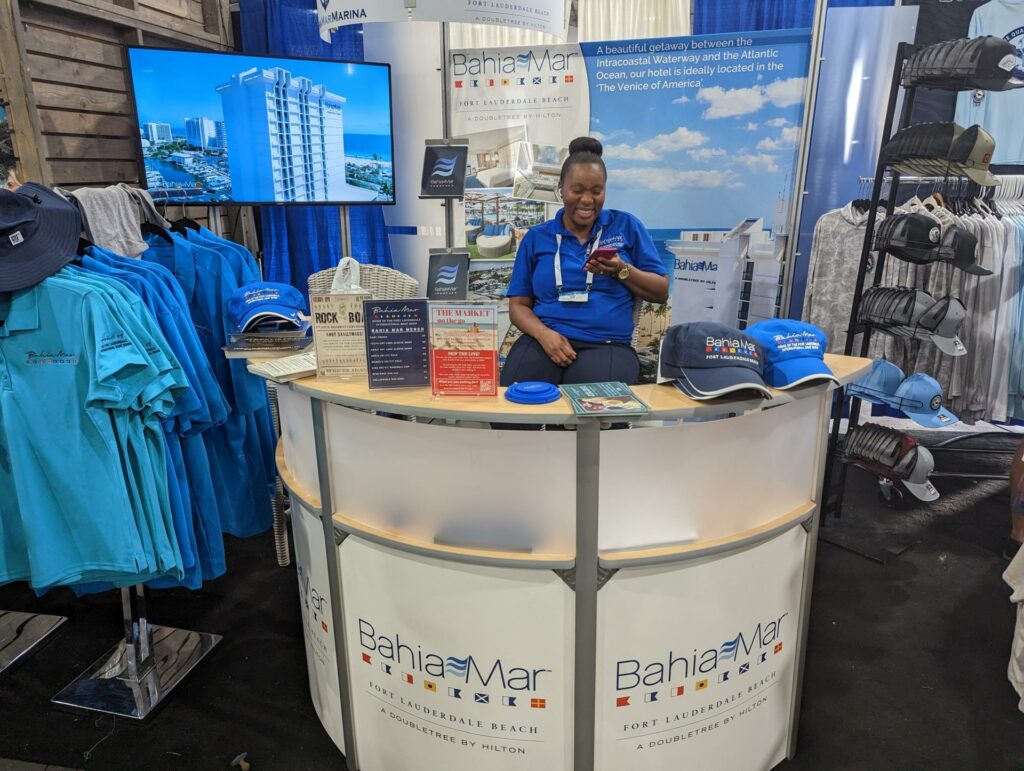
How to Set Up a Booth at a Trade Show? Technology and Equipment
In an era where technology permeates every facet of our lives, integrating it into your trade show booth is more than just a good idea—it’s imperative. Beyond the obvious aesthetic appeal, utilizing cutting-edge equipment and technology can significantly elevate the visitor experience, making your booth more memorable and engaging. Let’s dive deeper into how you can harness technology to create a dynamic and immersive booth environment.
Displays and Screens
Modern attendees are used to screens; they’re a staple in their daily lives. Capitalizing on this familiarity can be a game-changer for your booth.
Video Presentations: Beyond just playing a promotional clip, think of creating a narrative. A compelling storyline about your brand’s journey, ethos, or impact can deeply resonate with visitors.
- Slideshows: Instead of generic product images, consider incorporating customer stories, behind-the-scenes glimpses, or infographics that educate while they engage.
- Dynamic Content: Utilize motion graphics, animations, or even user-generated content. Changing content keeps the screen fresh and intriguing for repeated viewers.
- Placement and Size: Ensure your screens are positioned at strategic spots. Larger screens can act as a beacon, drawing attendees from afar, while smaller screens can engage them when they’re up close.
Lighting
Lighting is an art, and when done right, it can dramatically transform the feel and appeal of your booth.
- Spotlights: Beyond highlighting products, consider using them for live demos, interviews, or presentations. Dynamic lighting can shift focus as per the ongoing activity.
- Ambient Lighting: This isn’t just about brightness; it’s about mood. Warm lighting can create a cozy, intimate feel, while cooler lights can evoke a more professional or modern vibe.
- Colored Lighting: Play with hues that match your brand colors or the theme of the event. Syncing colored lights with specific activities or times of the day can add an element of surprise.
- LED Displays: Consider integrating LED strips or panels to add dynamic, color-changing backgrounds or underlighting to your booth design.
Read my article about trade show lighting.

Interactive Elements
Modern attendees appreciate hands-on experiences. It makes your brand tangible and memorable.
- Touch Screens: Evolve beyond static displays. Use interactive screens where attendees can customize products, navigate a digital catalog, or even play branded games.
- Virtual Reality (VR) Setups: If feasible, a VR station can be a crowd-puller. It could simulate product usage, provide virtual tours, or immerse visitors in a story.
- Augmented Reality (AR): AR can overlay digital information on real-world elements. For instance, pointing a tablet at a product could bring up specs, reviews, or even a 3D model.
- Interactive Product Demos: Facilitate hands-on trials. It could be a new tool, software, or even a physical product. Interaction builds a connection.
Remember, the idea behind integrating technology and equipment is not just to show off but to enhance the overall experience and interaction attendees have with your brand. Thoughtful incorporation will ensure your booth isn’t just seen but remembered.
While technology and equipment play a pivotal role in ensuring your booth’s success at a trade show, the process of designing, building, and setting up can be overwhelming. However, the key is to balance innovation with simplicity. If you wish to have a trade show booth that’s both professional and free of technical hassles, consider opting for one of the Turnkey Rental Kits from Everything Tradeshows.
For many businesses, the primary hurdle in trade show participation is the cost and complexity of buying and setting up a convention display. But Everything Tradeshows offers a solution that’s both elegant and practical. Their trade show booth rental are not just any booths. These are pre-designed, state-of-the-art structures that seamlessly blend functionality with aesthetics. Whether you need specific trade show furniture, monitors, or other standard trade show amenities, each rental exhibit booth can be tailored to your requirements. And the best part? Your company’s unique brand graphics are intricately integrated throughout the booth, ensuring it’s unmistakably yours.
The brilliance of Everything Tradeshows’ offerings lies in their deceptive simplicity. At first glance, these booths don’t come off as rentals. They stand tall, fully branded, rivaling the quality of purchased booths, but with the added benefits of cost-efficiency and customization. So, if you’re aiming for a high-quality exhibit that leaves a lasting impression without the associated hassles, Everything Tradeshows is your go-to destination.
How to Set Up a Booth at a Trade Show to Showcase Your Best
When you’re at a trade show, your products are the stars of the show. It’s essential that they’re displayed in a manner that not only grabs attention but also immerses attendees in the brand experience. From the layout to engaging the senses, let’s explore how to effectively showcase your offerings to make a lasting impact.
Layout
The layout of your products is more than just placing them on a table or shelf. Thoughtful positioning can influence how attendees perceive and interact with them:
- Central Placement: Position your flagship products or best-sellers centrally. It draws attention and signifies their importance.
- Easy Access: Ensure attendees can easily approach, view, and, if appropriate, touch the products. Avoid creating barriers or clutter.
- Flow: Organize products in a manner that encourages attendees to naturally flow from one product to the next, telling a cohesive story about your brand or range.

Engage the Senses
Products aren’t just visual. Engaging multiple senses can make your booth memorable:
- Tactile Experiences: If your product can be touched, felt, or worn, encourage it. Letting attendees feel the quality or functionality can be persuasive.
- Smell: If relevant (e.g., for beauty or food products), subtle fragrances can invoke certain emotions or memories. A pleasant scent can attract and linger in the minds of attendees.
- Sounds: Background music or product-related sounds can set the mood. For instance, if you’re selling outdoor equipment, the sounds of nature can enhance the experience.
Live Demos
There’s no better way to showcase the value and functionality of a product than by demonstrating it:
- Scheduled Demos: Set specific times for live demonstrations, allowing attendees to gather and watch.
- Interactive Demos: Encourage attendees to try the product themselves under guided supervision. It adds a personal touch and can answer any immediate questions.
- Highlight Key Features: Ensure the demo focuses on the product’s unique selling points and benefits, addressing common problems it might solve for potential customers.
By thoughtfully designing your product display, you ensure that attendees not only see your offerings but truly experience what sets them apart. It’s this immersive experience that can turn casual browsers into potential customers.
How to Set Up a Booth at a Trade Show to Captivate Attendees
In the bustling atmosphere of a trade show, engaging attendees becomes the heartbeat of a successful exhibit. It’s about transcending beyond the confines of your booth to create moments of genuine connection, turning casual passersby into interested participants who carry a memorable piece of your brand with them.
Active Staff
Having an active staff at your booth is pivotal. Before the show begins, it’s essential to invest time in training them thoroughly about your products and the story of your brand. Their knowledge becomes the bridge that links curious attendees to your offerings. But knowledge alone isn’t enough. The warmth of a genuine greeting, the openness of attentive body language, and the earnestness in listening to an attendee’s queries or feedback can often be the difference between a fleeting visit and a fruitful conversation. Each staff member should be an embodiment of your brand’s values, striking the right balance between being informative and being personable.
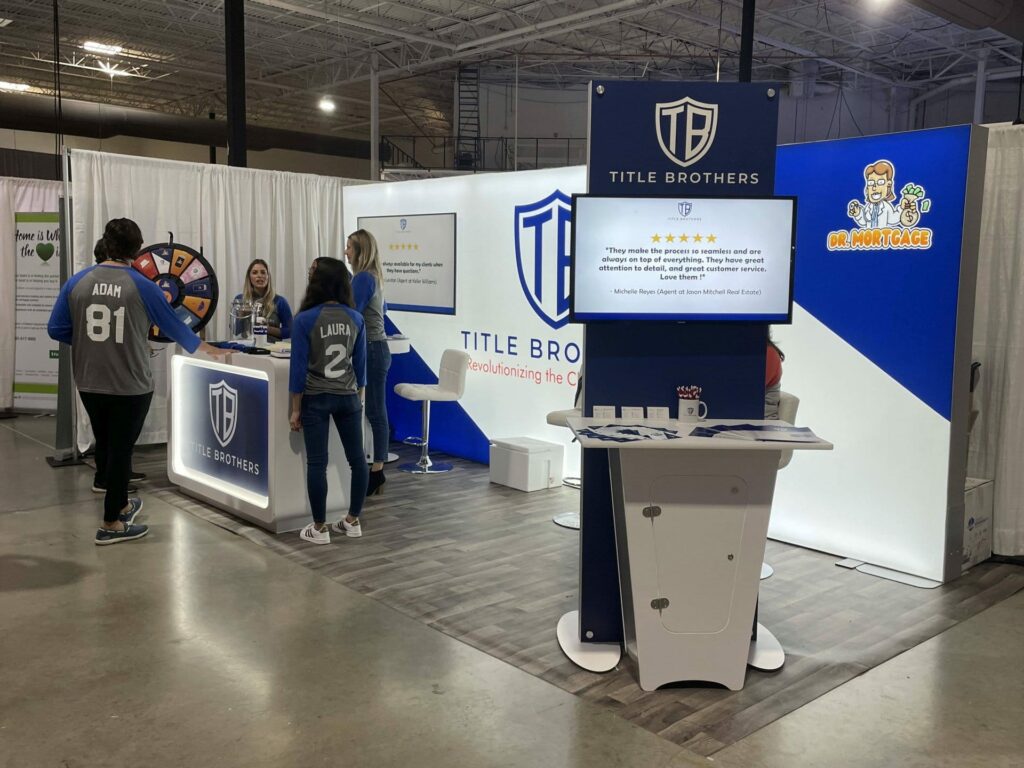
Activities or Contests
Incorporating interactive activities or contests can inject an element of fun and spontaneity into the trade show experience. Imagine a tech company offering a firsthand experience with their latest VR technology or a food brand letting attendees indulge in a taste-testing session. These activities not only showcase products but also create a buzz, making your booth a hub of activity. And then there’s the excitement of contests. The allure of a giveaway, especially if it’s something of value or exclusivity, can act as a magnet, drawing attendees to your booth. To maximize participation, consider promoting these activities in advance and displaying information about them prominently at your booth.
Collect Contact Details
While the trade show provides a platform for immediate interactions, the relationships you cultivate have the potential to grow well beyond the event’s duration. Setting up a system to collect contact details from interested attendees is akin to sowing seeds for future engagements. Consider integrating user-friendly digital sign-up methods, like tablets or kiosks, to make the process seamless. To encourage sign-ups, you could offer incentives, perhaps a discount on their next purchase or exclusive access to upcoming product launches. Equally crucial is to assure attendees of the privacy and security of their data, reinforcing the trust they place in your brand.
In essence, engaging attendees is an art. It’s about crafting experiences that resonate, forging connections that linger, and setting the stage for future interactions. In the vast ocean of trade show booths, let yours be the one that attendees can’t stop talking about.
Read my article about how to sell at trade shows.
How to Set Up a Booth at a Trade Show? The Practicalities
While dazzling displays and engaging activities can steal the spotlight at trade shows, there’s a foundational layer of practicalities that acts as the bedrock for any successful booth. This layer might seem mundane, but without it, the entire experience can falter. Dive into the world of booth setup, storage solutions, and safety protocols, and discover how to keep the cogs turning smoothly behind the scenes.
Setting Up
The first step to a successful trade show experience is the setup phase. Here, punctuality is your best ally. Arriving early provides a cushion against unexpected delays – maybe there’s a missing component, or perhaps a piece of equipment isn’t working as it should. By allocating extra time, you grant yourself the luxury of troubleshooting without the stress of the ticking clock. And while it’s essential to have a plan in place, flexibility is equally crucial. Sometimes, the realities of the trade show floor might demand a quick change in layout or display arrangement. Being prepared for these contingencies ensures a smoother setup experience.
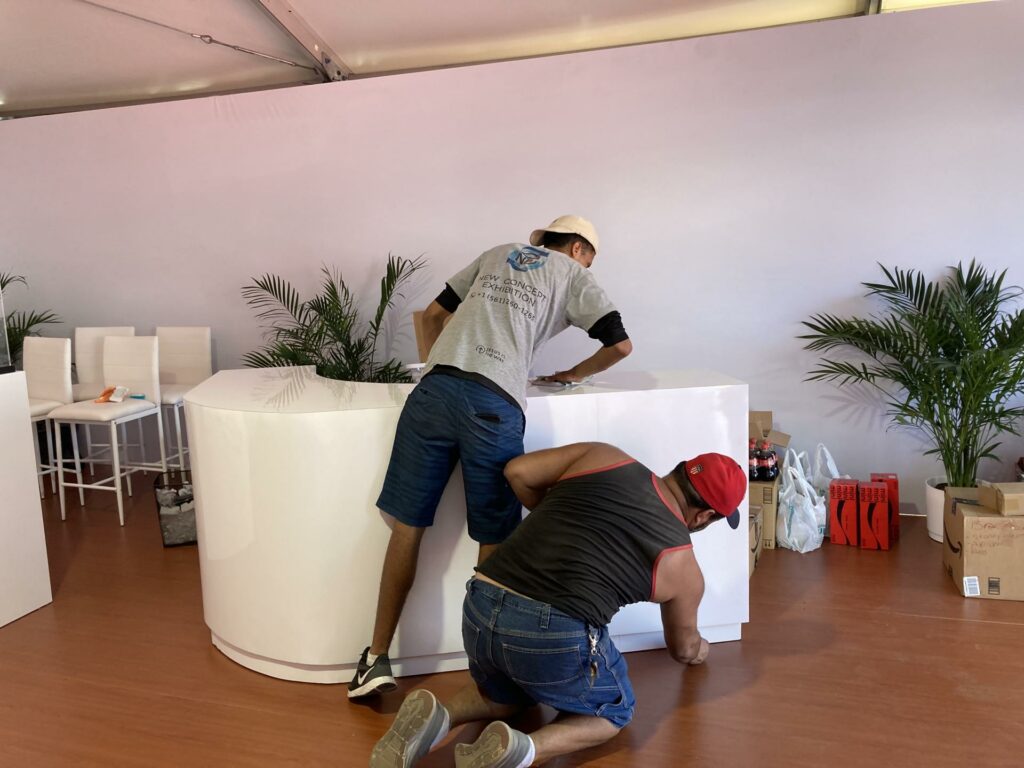
Read my article about how to prepare for a trade show.
Storage
No matter how sleek your booth design, the reality is there will be extra items – promotional materials, personal belongings, or additional stock. It’s essential that these items don’t clutter your display or hinder movement. Consider:
- Integrated Storage: Design your booth with built-in compartments or drawers that can discreetly hold extra items.
- Easy Access: While you want these items hidden from attendees’ view, ensure that they’re easily accessible to your staff. The last thing you want is to rummage through a mountain of boxes when an attendee requests more information or a product demo.
- Labeling: If you’re using multiple storage boxes, having them labeled can speed up retrieval times, keeping your booth operations smooth and efficient.
Safety First
Trade show booths often have a maze of cables and equipment, and amidst the excitement, safety can sometimes take a backseat. But it’s paramount. A few key considerations can ensure both your staff and attendees are safe:
- Cable Management: Use cable ties or cable covers to bundle and secure loose wires. Not only does this prevent tripping hazards, but it also keeps the booth looking tidy.
- Stable Displays: Double-check that all displays, especially taller structures, are secure. Anchor them if necessary to ensure they won’t topple over with a slight nudge or bump.
- Clear Pathways: Ensure that there’s a clear path for attendees to move through your booth. Avoid placing items in walkways that might cause attendees to trip or stumble.
By paying close attention to these practicalities, you pave the way for a seamless trade show experience. It’s about ensuring that the behind-the-scenes operations bolster, rather than hinder, the spotlight moments.
Within the realm of trade show practicalities, one solution is standing out for businesses looking to streamline their booth management process: renting a Turnkey Rental Kit from Everything Tradeshows. These pre-designed booths, while being contemporary and chic, can be tailored with various trade show furnishings, monitors, and other essential features. What makes these rentals truly shine is the infusion of your brand’s unique graphics throughout, making the booth distinctly yours. Attendees will be none the wiser that it’s a rental – such is the quality and customization on offer.
The brilliance of this approach lies in its alleviation of typical booth concerns. The setup becomes seamless, as professionals handle it. Storage is integrated and thoughtfully designed, ensuring personal belongings or extra stock remain out of sight yet within easy reach. And, paramount to a bustling trade show floor, the safety and stability of these booths are impeccable, reducing the risks of accidents. So, for businesses keen on minimizing logistical hassles while maximizing booth impact, Everything Tradeshows offers a compelling, practical solution.
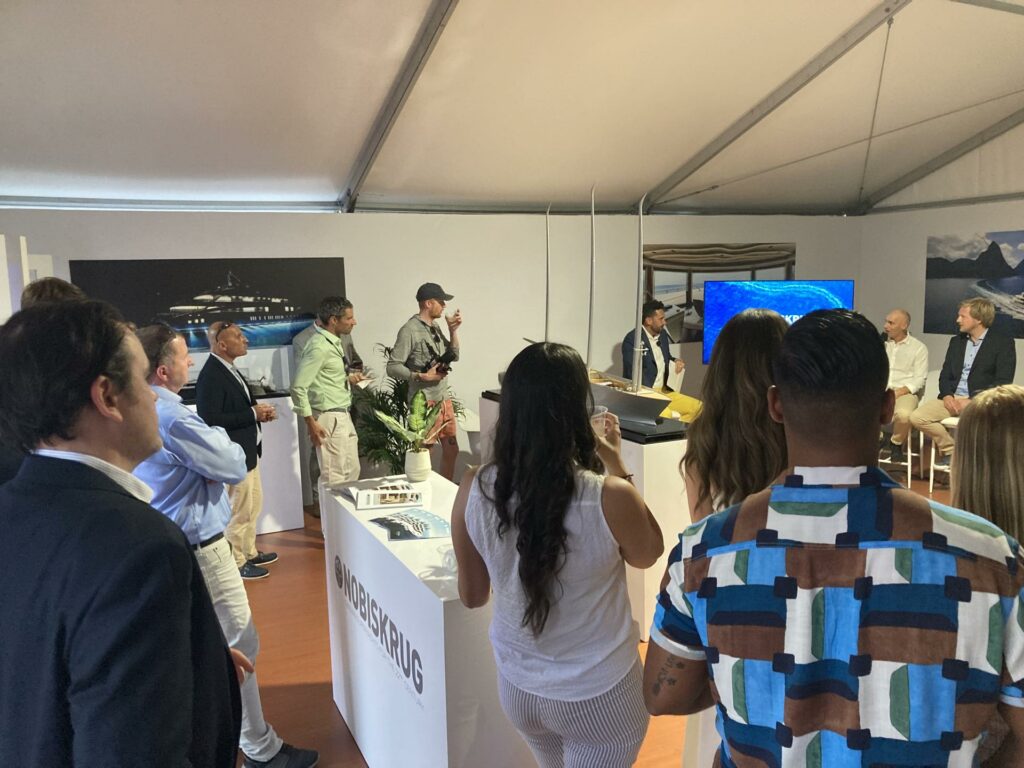
Strategies for Converting Booth Visits into Lasting Business Relationships
The curtains have fallen, and the trade show has ended, but for businesses aiming for growth, the journey is just beginning. The post-trade show period is a golden opportunity to capitalize on the connections made, lessons learned, and momentum built. It’s a phase of reflection, engagement, and strategic planning. So, let’s navigate this crucial aftermath and explore ways to ensure the seeds sown during the trade show bear fruit in the days to come.
Analyze Performance
Post-event, it’s essential to take a step back and assess your performance. This isn’t just about tallying sales or leads but understanding how well you met your overarching objectives:
- Did you aim for brand awareness? If so, was there a notable uptick in your online engagement or mentions post-show?
- Were sales the primary goal? Then, how do the numbers stack up against expectations?
- For those looking at networking, was there a significant number of valuable industry contacts made?
Reflection is the cornerstone of growth. By genuinely understanding where you excelled and where you fell short, you lay the groundwork for more targeted strategies in the future.
Read my article about why exhibit at a trade show.
Contact New Leads
The contacts made during a trade show are fresh leads waiting to be nurtured. But the key is timely and relevant engagement:
- A simple ‘thank you for visiting our booth’ note can go a long way in making your brand memorable.
- Did an attendee show particular interest in a product or service? Tailor your follow-up with more information or even an exclusive promotional offer.
- Remember, it’s not just about making a sale. It’s about building a relationship. Even a non-promotional check-in, asking for feedback or thoughts about the trade show, can solidify your brand’s position in the lead’s mind.
Plan for Next Time
No trade show experience is perfect. There are always lessons to be learned and tweaks to be made:
- Were there logistical issues you hadn’t anticipated? Maybe the booth setup took longer than expected or storage solutions weren’t efficient.
- Feedback from attendees is gold. Were they looking for something that wasn’t on display? Did they find the booth’s layout confusing?
- Based on the performance analysis, adjust your objectives or strategies for the next show. Maybe it’s time to invest more in interactive displays or ramp up pre-show promotions.Embracing the mindset of continuous improvement ensures that with each trade show, your brand’s presence becomes more impactful and resonant.
In the grand tapestry of trade shows, the event itself might be the most visible thread, but the post-show follow-up gives depth and texture to the narrative. It’s about ensuring that the energy and resources poured into the trade show aren’t just for a fleeting moment of engagement but become the foundation of lasting business growth.
How to Set Up a Booth at a Trade Show? Conclusion
Trade shows, with their whirlwind of activities and plethora of interactions, can often feel like an exhilarating marathon. But as we’ve journeyed through the various facets – from pre-planning to post-event follow-ups – it becomes clear that the real magic lies not just in the event itself but in the meticulous preparation beforehand and the proactive engagements afterward.
Starting with a clear vision, understanding the guidelines, and setting objectives paves the way for a booth that not only stands out but also serves its purpose. Whether it’s through impactful branding, integrating the right technology, or presenting products in the most captivating manner, every detail contributes to creating an unforgettable experience for attendees. And let’s not forget the importance of human interactions, where trained and active staff can turn a casual visit into a meaningful connection.
Post-event, the momentum must continue. Reflection, engagement, and planning form the trifecta that ensures the trade show’s impact is maximized. By understanding performance, nurturing new leads, and drawing lessons for future events, businesses can truly capitalize on their trade show investments.
In the end, success at trade shows is not measured merely by the footfall at your booth or the immediate sales generated. It’s gauged by the lasting relationships fostered, the brand recall achieved, and the continuous improvement one commits to. So, as you step into the world of trade shows, embrace the holistic approach, and let every phase – before, during, and after – be a testament to your brand’s vision and commitment.
How to Set Up a Booth at a Trade Show? FAQs
What’s the first thing to consider when setting up a booth at a trade show?
Before any setup, it’s essential to understand the trade show’s guidelines. This includes knowing the booth dimensions, available power outlets, Wi-Fi access, and any other facilities or limitations set by the organizers.
Why is it essential to set clear objectives for your booth?
Setting clear objectives helps to define your booth’s purpose, whether it’s generating sales, raising brand awareness, or networking. This focus will guide your booth design, activities, and how you engage with attendees.
How important is branding for my booth?
Branding is crucial. It ensures that attendees recognize and remember your company. This includes displaying your logo and company name prominently and maintaining a consistent color scheme that aligns with your brand.
What technological equipment can enhance my booth’s appeal?
Incorporating displays and screens for video presentations, utilizing unique lighting to emphasize products, and adding interactive elements like touch screens or VR setups can make your booth more engaging and memorable.
How should products be displayed at the booth?
Position products centrally and accessibly, allowing attendees to engage with them. If possible, offer tactile experiences, use sensory elements relevant to the product, and consider live demos to showcase the product in action.
How can I ensure my staff effectively engage with attendees?
Training is key. Equip your booth staff with the skills to greet, provide information, and actively engage attendees. Role-playing potential scenarios can help staff feel more prepared.
Are there any activities that can attract more attendees to my booth?
Yes, hosting activities or contests related to your product or industry can draw attention. Think of interactive games, giveaways, or even short seminars that offer value to attendees.
How should I manage storage at my booth?
Design a designated storage area, preferably at the back or a concealed section of your booth. This keeps extra stock or personal items out of sight but within easy reach for staff.
Why is safety crucial for booth setup?
Ensuring that all cables are secured and displays are stable is vital to prevent accidents. A safe booth ensures the well-being of both staff and attendees and avoids potential legal complications.
After the trade show ends, what should be my immediate next steps?
Reflect on your booth’s performance against set objectives, reach out to the new leads you’ve gathered with follow-up messages, and begin planning improvements for your next trade show based on feedback and experiences.
Learn more about trade show best practices:
- Uncover key strategies for exhibitors to enhance the impact of their trade show booths.
- Discover ways to gather potential clients during a trade show.
- Explore effective strategies on how to display clothing at a trade show to boost visitor engagement.
- Unsure about showcasing products at a trade show? Check out our guide for tips.
- Implementing engaging activities is essential for learning how to attract people to your booth.
- Explore strategies on how to get exhibitors for a trade show.
- Discover more about creating an effective and successful trade show booth.
- Discover how to make your trade show booth stand out with these innovative design tips!
- To enhance your marketing skills, learn how to plan a trade show for maximum impact and audience engagement.
- Effective research is vital in understanding how to prepare for a trade show.
- Discover the art of effective selling at trade shows to enhance your business’s reach and impact.
- Discover the best practices on how to ship to a trade show for a seamless experience.
- Many businesses boost their revenue by selling at trade shows. Read our blog post.
- Here are some trade show attendee tips to help you make the most of your experience.
- Explore our guide about trade show best practices.
- Remember to go over the trade show checklist before the event to confirm that all is set and ready.
- Here are some trade show exhibitor tips to help you succeed at your next event.
- Looking for trade show giveaway ideas? Check out our selection of promotional products!
- Here are some trade show giveaway ideas to attract visitors to your booth.
- What makes a good trade show booth? Find out in our latest blog post.
- Looking for trade show banner ideas? Check out our latest design inspirations!
- What to wear to a trade show? Read our guide.
- Are you interested in what type of promotion takes place at trade shows? Explore this topic.
- Why attend trade shows? Discover the best arguments.
- Why do exhibitors attend trade shows? Read more on our blog.
- Discover the answer to this common question: Why exhibit at a trade show?
- Learn more about why are trade shows important.

It’s in the name! Everything Tradeshows is your one-stop shop for all things trade shows, including booth purchases, booth rentals, and complete brand management services. Ready to get started? Have questions? Get in touch by calling us at (954) 791-8882 or by filling out the form below. We can’t wait to hear from you!

